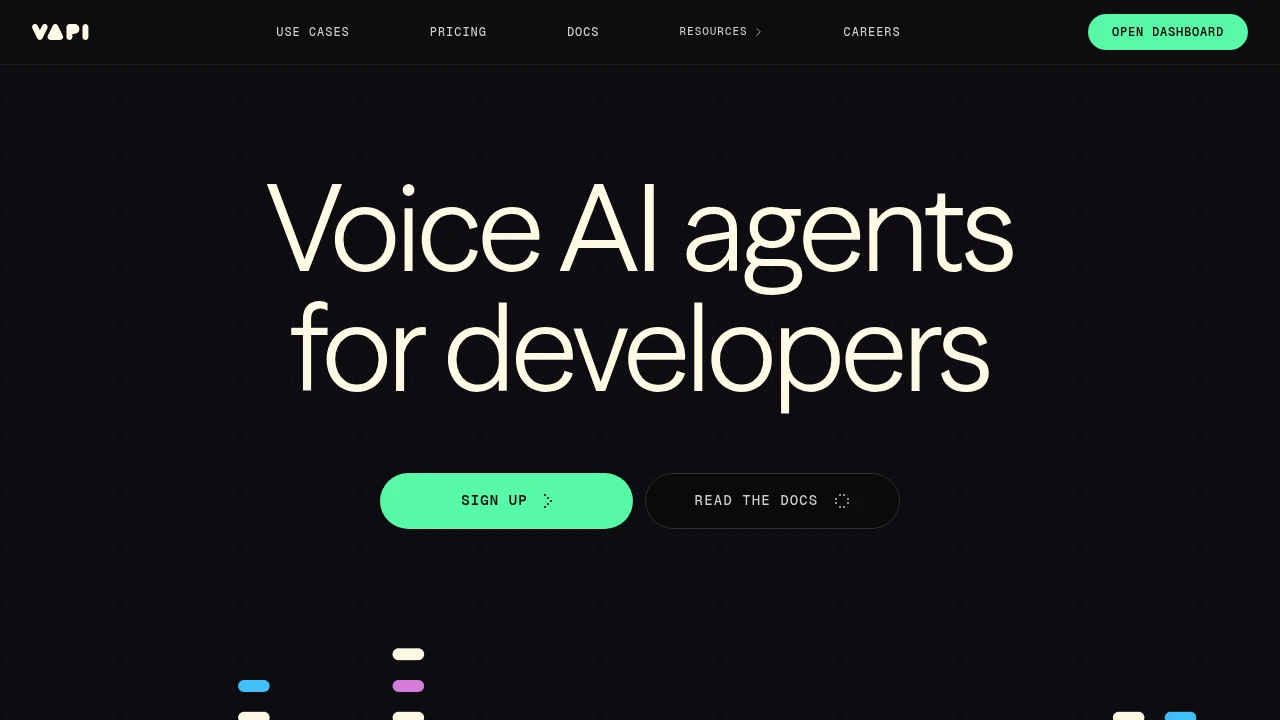VAPI.ai
VAPI.ai powers AI phone agents to manage bookings, sales, and customer support through natural voice calls.

VAPI.ai Features & Overview
Vapi is a voice AI platform for developers and CX teams. You connect speech recognition, text to speech, and large language models to a telephony or WebRTC stack, then wire tools and data so the agent completes real tasks. The runtime streams audio, handles barge-in, and calls functions against your APIs or databases. You configure prompts, policies, and integrations in a dashboard or code. Teams launch numbers, test flows in a web dialer, track outcomes, and scale traffic with production observability.
Core Features
- Real-time streaming and barge-in: Handle sub-second turn taking with incremental ASR, partial synthesis, and interruption detection. The agent stops speaking when callers interject, then resumes with context intact, which keeps conversations natural under noisy conditions.
- Tool calling and function execution: Expose actions as structured tools that the model can call with validated arguments. Define timeouts, retries, and side effects, then return typed results that the agent can confirm back to the caller with clarity.
- Telephony and SIP routing: Connect PSTN through providers, bring your SIP trunk, and manage numbers, IVR menus, and DTMF capture. Support call transfer, warm handoff, and voicemail while preserving transcripts and key entities for downstream systems.
- WebRTC and in-app voice: Embed a browser or mobile widget to start calls from your app with echo cancellation and device controls. Stream audio bi-directionally, show live captions, and switch between phone and web without losing the session state.
- Knowledge and retrieval: Attach documents, URLs, or backend search to power grounded answers. Configure chunking, embeddings, and freshness policies so the agent quotes current data and cites the source in logs for QA.
- Authentication and sensitive data handling: Verify identity with knowledge checks or one-time codes. Redact PII in transcripts, pause recording during payment entry, and emit masked events so downstream stores never receive raw secrets.
- Prompt, persona, and voice controls: Set system prompts, tone, and interruption thresholds per line of business. Choose neural voices, tune speaking rate and prosody, and switch languages mid-call when callers ask for a different locale.
- Analytics and QA review: Inspect transcripts with diarization, sentiment, containment, and handle time. Tag outcomes, filter failure modes, and export labeled calls to improve prompts, tools, and routing rules with measurable gains.
- Testing and evaluation runs: Script scenarios and run synthetic calls that assert tool outputs and phrasing. Compare model versions, long prompts, and voice settings, then promote the best configuration with a tracked version ID.
- Human handoff with full context: Escalate on confidence drops or policy triggers. Send the live transcript, entities, verified identity, and suggested next actions to agents so callers never repeat themselves during transfer.
- Developer SDKs and webhooks: Use REST and client SDKs for Node and Python to manage agents, sessions, and tools. Subscribe to events like started, tool_called, and completed, and verify signatures before mutating internal systems.
- Operations and reliability: Route traffic by region, set concurrency caps, and configure retries and fallbacks for ASR, TTS, or models. Health checks and alarms surface latency spikes, API outages, and unusual failure patterns before queues back up.
Supported Platforms / Integrations
- PSTN carriers and SIP trunks
- WebRTC widgets for web and mobile
- LLMs, ASR, and TTS providers
- CRMs, ticketing, and payment gateways
- REST APIs, webhooks, and databases
- Analytics exports and data warehouses
Use Cases & Applications
- Reservations, bookings, and order changes for hospitality and retail
- Banking and insurance authentication, balances, and claims status
- Logistics delivery updates, returns, and routing exceptions
- Healthcare scheduling, reminders, and benefits questions
Pricing
- Free: $0 with minute and feature limits
- Developer: usage based per minute with volume discounts
- Team: contact sales
- Enterprise: contact sales
Why You’d Love It
- Ships lifelike phone agents that actually complete tasks
- Grounds answers in your data and tools, not static scripts
- Gives observability, testing, and guardrails that production teams expect
Pros & Cons
Pros
- Real-time streaming with barge-in keeps conversations fluid
- Tool calling and webhooks connect agents to real workflows
- Strong analytics, testing, and handoff improve outcomes over time
Cons
- Telephony setup and data wiring add initial effort
- Usage costs require forecasting for seasonal peaks
Conclusion Vapi turns voice demand into resolved work. You connect models, speech, and tools, then launch agents that authenticate callers, fetch answers, run transactions, and escalate when needed. The platform gives you speed, control, and the production signals required to scale confidently.